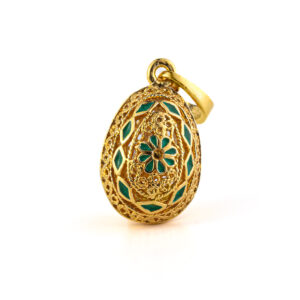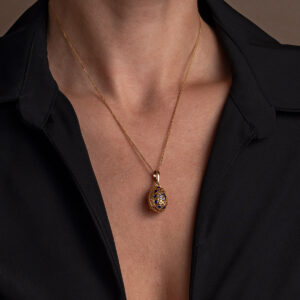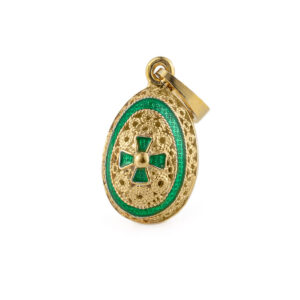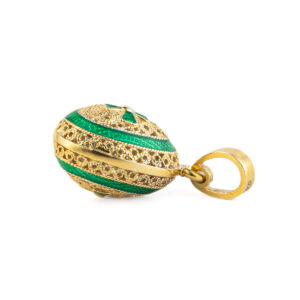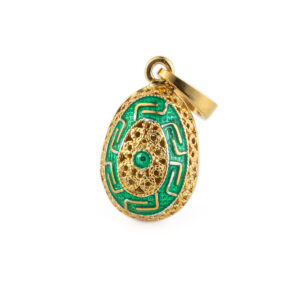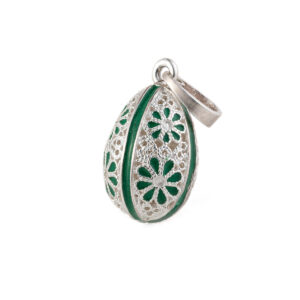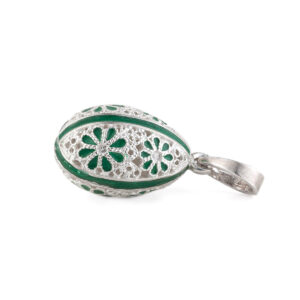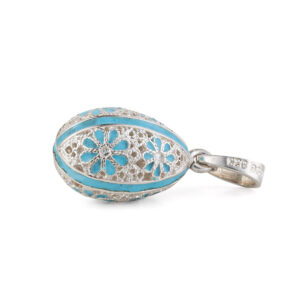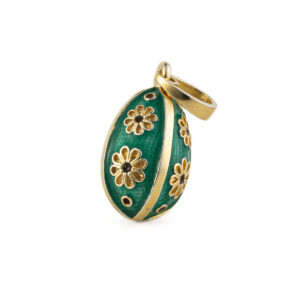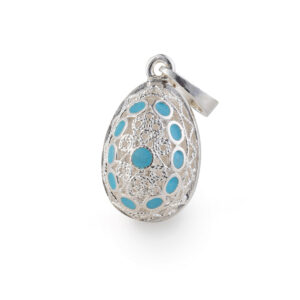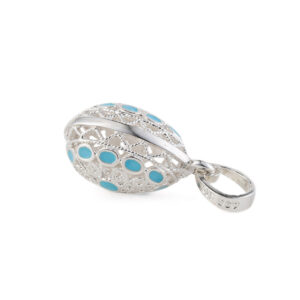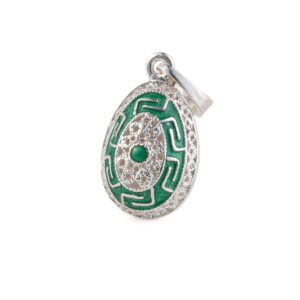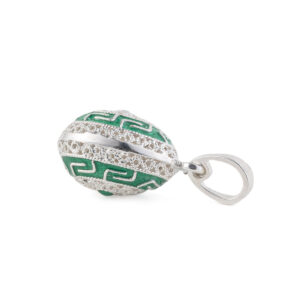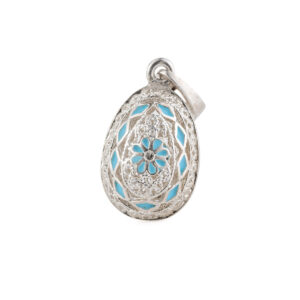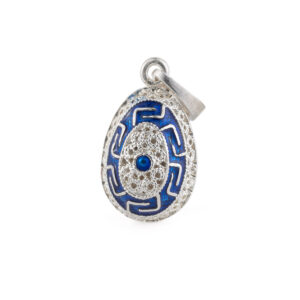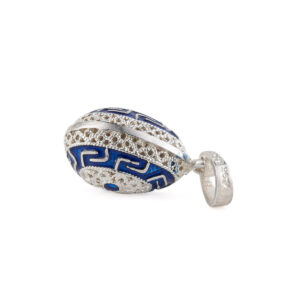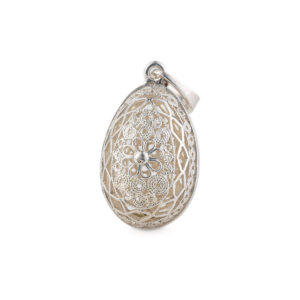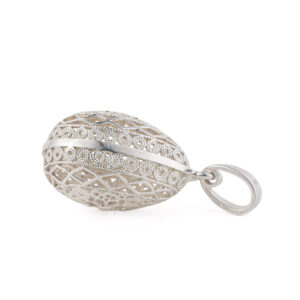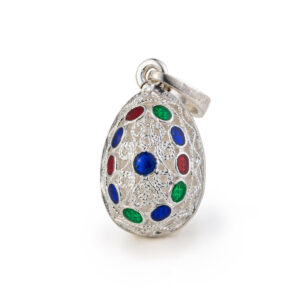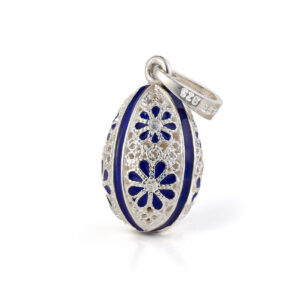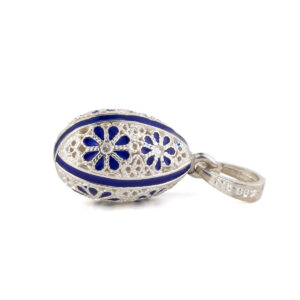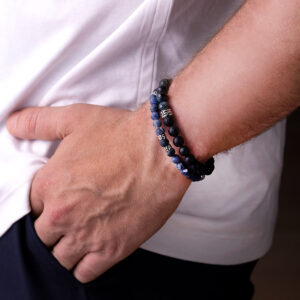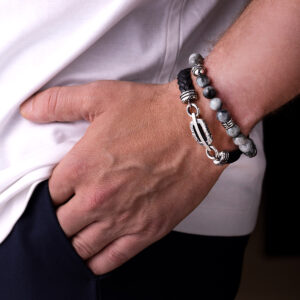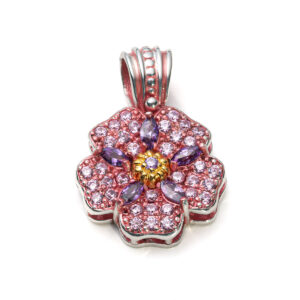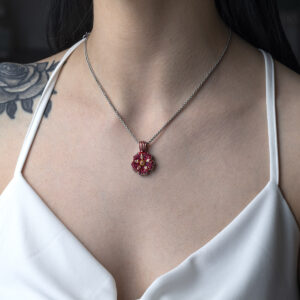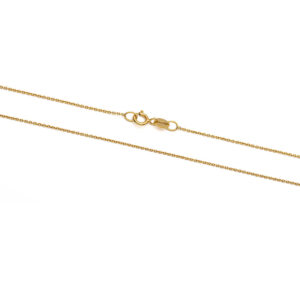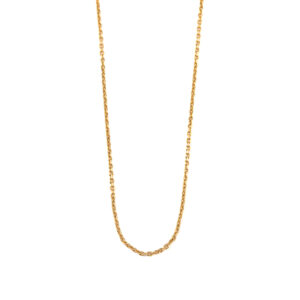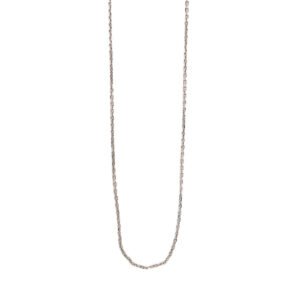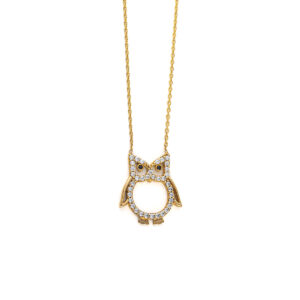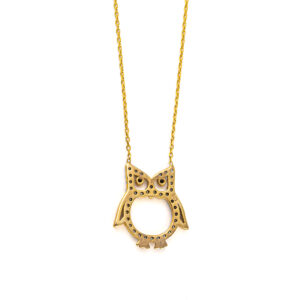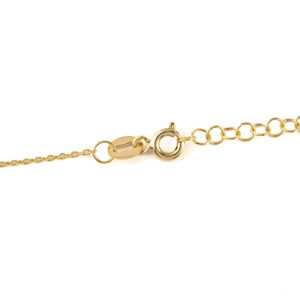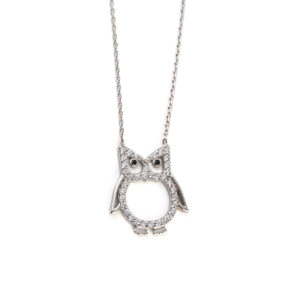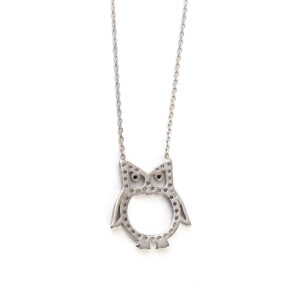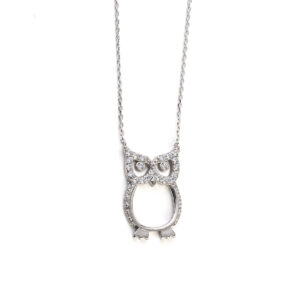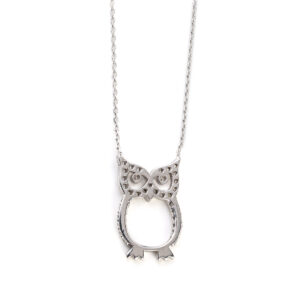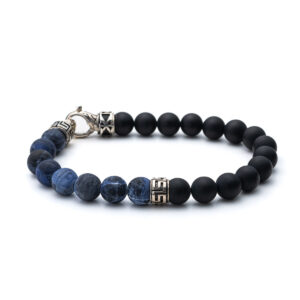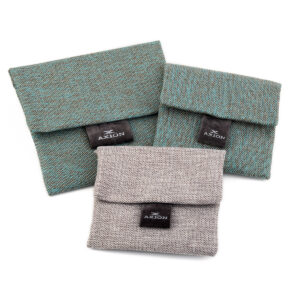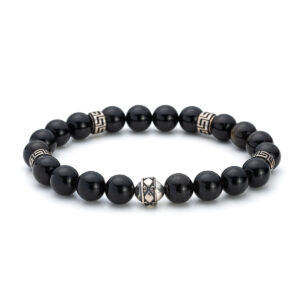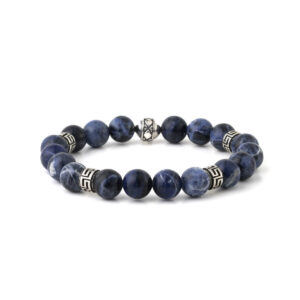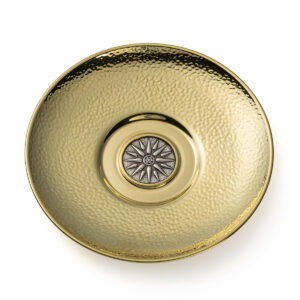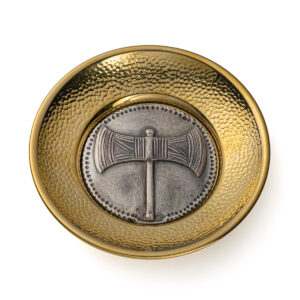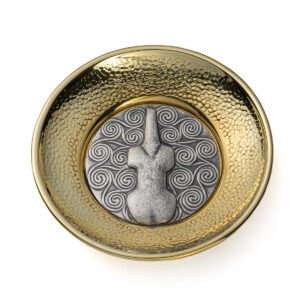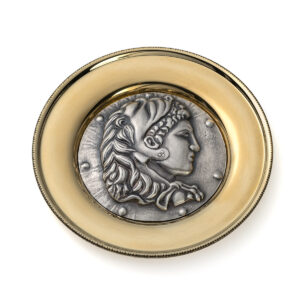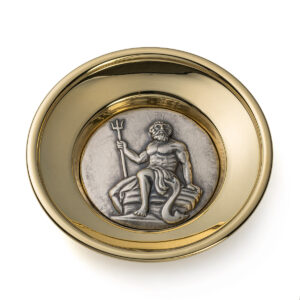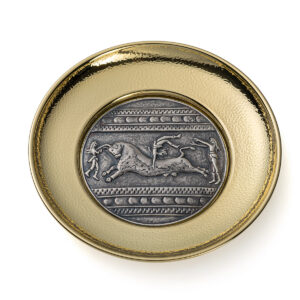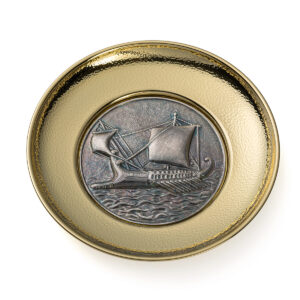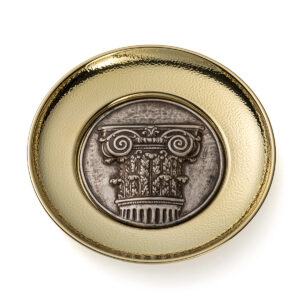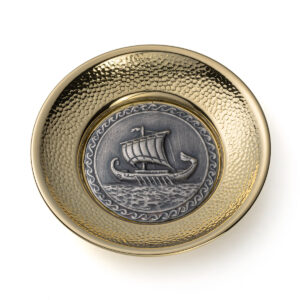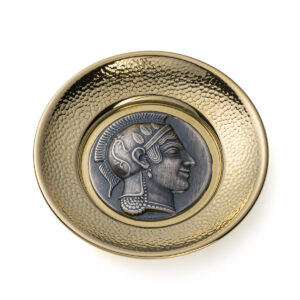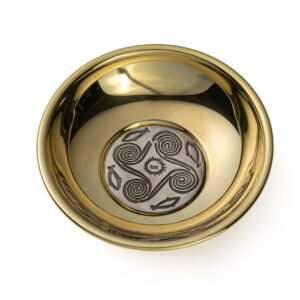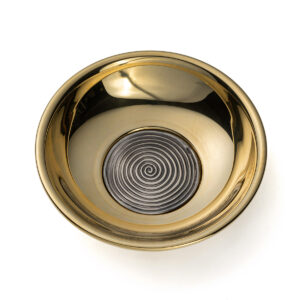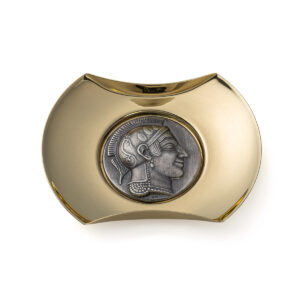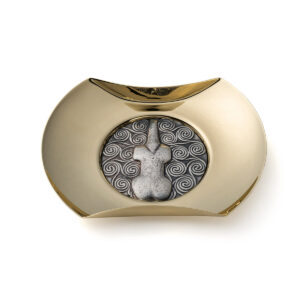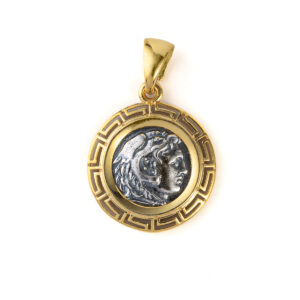Κολιέ με Μενταγιόν Αυγό – Ασήμι 925
The pendant is embellished with a fine filigree and enamel in Faberge style.
Made of 925 sterling silver.
Handmade in Greece.
The chain shown is included.
Filigree is a delicate kind of jewellery metalwork, made with tiny beads or twisted threads, or both in combination, soldered together or to the surface of an object of the same metal and arranged in artistic motifs. The art of filigree dates back to ancient history. The first of the found jewelry in this technique have been found in Mesopotamia and dates to thousands of years BC. In the ancient world and particularly in Asia Minor, this art grew were at the highest level.
Fabergé egg is a jeweled egg created by the House of Fabergé, in St. Petersburg, Imperial Russia. Virtually all were manufactured under the supervision of Peter Carl Fabergé between 1885 and 1917,[citation needed] the most famous being the 50 “Imperial” eggs, 43 of which survive, made for the Russian Tsars Alexander III and Nicholas II as Easter gifts for their wives and mothers. The first Fabergé egg was crafted for Tsar Alexander III, who had decided to give his wife, the Empress Maria Feodorovna, an Easter egg in 1885. Peter Carl Fabergé was a Russian jeweller best known for the famous Fabergé eggs made in the style of genuine Easter eggs, using precious metals and gemstones. He’s the founder of the famous jewelry legacy House of Fabergé.
Κολιέ με Μενταγιόν Αυγό – Ασήμι 925 Επιχρυσωμένο
The pendant is embellished with a fine filigree and enamel in Faberge style.
Made of 925 sterling silver and gold plated.
Handmade in Greece.
The chain shown is included.
Filigree is a delicate kind of jewellery metalwork, made with tiny beads or twisted threads, or both in combination, soldered together or to the surface of an object of the same metal and arranged in artistic motifs. The art of filigree dates back to ancient history. The first of the found jewelry in this technique have been found in Mesopotamia and dates to thousands of years BC. In the ancient world and particularly in Asia Minor, this art grew were at the highest level.
Fabergé egg is a jeweled egg created by the House of Fabergé, in St. Petersburg, Imperial Russia. Virtually all were manufactured under the supervision of Peter Carl Fabergé between 1885 and 1917,[citation needed] the most famous being the 50 “Imperial” eggs, 43 of which survive, made for the Russian Tsars Alexander III and Nicholas II as Easter gifts for their wives and mothers. The first Fabergé egg was crafted for Tsar Alexander III, who had decided to give his wife, the Empress Maria Feodorovna, an Easter egg in 1885. Peter Carl Fabergé was a Russian jeweller best known for the famous Fabergé eggs made in the style of genuine Easter eggs, using precious metals and gemstones. He’s the founder of the famous jewelry legacy House of Fabergé.
Κολιέ με Μενταγιόν Αυγό – Ασήμι 925 Επιχρυσωμένο
The pendant is embellished with a fine filigree and enamel in Faberge style.
Made of 925 sterling silver and gold plated.
Handmade in Greece.
The chain shown is included.
Filigree is a delicate kind of jewellery metalwork, made with tiny beads or twisted threads, or both in combination, soldered together or to the surface of an object of the same metal and arranged in artistic motifs. The art of filigree dates back to ancient history. The first of the found jewelry in this technique have been found in Mesopotamia and dates to thousands of years BC. In the ancient world and particularly in Asia Minor, this art grew were at the highest level.
Fabergé egg is a jeweled egg created by the House of Fabergé, in St. Petersburg, Imperial Russia. Virtually all were manufactured under the supervision of Peter Carl Fabergé between 1885 and 1917,[citation needed] the most famous being the 50 “Imperial” eggs, 43 of which survive, made for the Russian Tsars Alexander III and Nicholas II as Easter gifts for their wives and mothers. The first Fabergé egg was crafted for Tsar Alexander III, who had decided to give his wife, the Empress Maria Feodorovna, an Easter egg in 1885. Peter Carl Fabergé was a Russian jeweller best known for the famous Fabergé eggs made in the style of genuine Easter eggs, using precious metals and gemstones. He’s the founder of the famous jewelry legacy House of Fabergé.
Κολιέ με Μενταγιόν Αυγό – Ασήμι 925 Επιχρυσωμένο
The pendant is embellished with a fine filigree and enamel in Faberge style.
Made of 925 sterling silver and gold plated.
Handmade in Greece.
The chain shown is included.
Filigree is a delicate kind of jewellery metalwork, made with tiny beads or twisted threads, or both in combination, soldered together or to the surface of an object of the same metal and arranged in artistic motifs. The art of filigree dates back to ancient history. The first of the found jewelry in this technique have been found in Mesopotamia and dates to thousands of years BC. In the ancient world and particularly in Asia Minor, this art grew were at the highest level.
Fabergé egg is a jeweled egg created by the House of Fabergé, in St. Petersburg, Imperial Russia. Virtually all were manufactured under the supervision of Peter Carl Fabergé between 1885 and 1917,[citation needed] the most famous being the 50 “Imperial” eggs, 43 of which survive, made for the Russian Tsars Alexander III and Nicholas II as Easter gifts for their wives and mothers. The first Fabergé egg was crafted for Tsar Alexander III, who had decided to give his wife, the Empress Maria Feodorovna, an Easter egg in 1885. Peter Carl Fabergé was a Russian jeweller best known for the famous Fabergé eggs made in the style of genuine Easter eggs, using precious metals and gemstones. He’s the founder of the famous jewelry legacy House of Fabergé.
Κολιέ με Μενταγιόν Αυγό – Ασήμι 925
The pendant is embellished with a fine filigree and enamel in Faberge style.
Made of 925 sterling silver.
Handmade in Greece.
The chain shown is included.
Filigree is a delicate kind of jewellery metalwork, made with tiny beads or twisted threads, or both in combination, soldered together or to the surface of an object of the same metal and arranged in artistic motifs. The art of filigree dates back to ancient history. The first of the found jewelry in this technique have been found in Mesopotamia and dates to thousands of years BC. In the ancient world and particularly in Asia Minor, this art grew were at the highest level.
Fabergé egg is a jeweled egg created by the House of Fabergé, in St. Petersburg, Imperial Russia. Virtually all were manufactured under the supervision of Peter Carl Fabergé between 1885 and 1917,[citation needed] the most famous being the 50 “Imperial” eggs, 43 of which survive, made for the Russian Tsars Alexander III and Nicholas II as Easter gifts for their wives and mothers. The first Fabergé egg was crafted for Tsar Alexander III, who had decided to give his wife, the Empress Maria Feodorovna, an Easter egg in 1885. Peter Carl Fabergé was a Russian jeweller best known for the famous Fabergé eggs made in the style of genuine Easter eggs, using precious metals and gemstones. He’s the founder of the famous jewelry legacy House of Fabergé.
Κολιέ με Μενταγιόν Αυγό – Ασήμι 925
The pendant is embellished with a fine filigree and enamel in Faberge style.
Made of 925 sterling silver.
Handmade in Greece.
The chain shown is included.
Filigree is a delicate kind of jewellery metalwork, made with tiny beads or twisted threads, or both in combination, soldered together or to the surface of an object of the same metal and arranged in artistic motifs. The art of filigree dates back to ancient history. The first of the found jewelry in this technique have been found in Mesopotamia and dates to thousands of years BC. In the ancient world and particularly in Asia Minor, this art grew were at the highest level.
Fabergé egg is a jeweled egg created by the House of Fabergé, in St. Petersburg, Imperial Russia. Virtually all were manufactured under the supervision of Peter Carl Fabergé between 1885 and 1917,[citation needed] the most famous being the 50 “Imperial” eggs, 43 of which survive, made for the Russian Tsars Alexander III and Nicholas II as Easter gifts for their wives and mothers. The first Fabergé egg was crafted for Tsar Alexander III, who had decided to give his wife, the Empress Maria Feodorovna, an Easter egg in 1885. Peter Carl Fabergé was a Russian jeweller best known for the famous Fabergé eggs made in the style of genuine Easter eggs, using precious metals and gemstones. He’s the founder of the famous jewelry legacy House of Fabergé.
Κολιέ με Μενταγιόν Αυγό – Ασήμι 925 Επιχρυσωμένο
The pendant is embellished with a fine filigree and enamel in Faberge style.
Made of 925 sterling silver and gold plated.
Handmade in Greece.
The chain shown is included.
Filigree is a delicate kind of jewellery metalwork, made with tiny beads or twisted threads, or both in combination, soldered together or to the surface of an object of the same metal and arranged in artistic motifs. The art of filigree dates back to ancient history. The first of the found jewelry in this technique have been found in Mesopotamia and dates to thousands of years BC. In the ancient world and particularly in Asia Minor, this art grew were at the highest level.
Fabergé egg is a jeweled egg created by the House of Fabergé, in St. Petersburg, Imperial Russia. Virtually all were manufactured under the supervision of Peter Carl Fabergé between 1885 and 1917,[citation needed] the most famous being the 50 “Imperial” eggs, 43 of which survive, made for the Russian Tsars Alexander III and Nicholas II as Easter gifts for their wives and mothers. The first Fabergé egg was crafted for Tsar Alexander III, who had decided to give his wife, the Empress Maria Feodorovna, an Easter egg in 1885. Peter Carl Fabergé was a Russian jeweller best known for the famous Fabergé eggs made in the style of genuine Easter eggs, using precious metals and gemstones. He’s the founder of the famous jewelry legacy House of Fabergé.
Κολιέ με Μενταγιόν Αυγό – Ασήμι 925
The pendant is embellished with a fine filigree and enamel in Faberge style.
Made of 925 sterling silver.
Handmade in Greece.
The chain shown is included.
Filigree is a delicate kind of jewellery metalwork, made with tiny beads or twisted threads, or both in combination, soldered together or to the surface of an object of the same metal and arranged in artistic motifs. The art of filigree dates back to ancient history. The first of the found jewelry in this technique have been found in Mesopotamia and dates to thousands of years BC. In the ancient world and particularly in Asia Minor, this art grew were at the highest level.
Fabergé egg is a jeweled egg created by the House of Fabergé, in St. Petersburg, Imperial Russia. Virtually all were manufactured under the supervision of Peter Carl Fabergé between 1885 and 1917,[citation needed] the most famous being the 50 “Imperial” eggs, 43 of which survive, made for the Russian Tsars Alexander III and Nicholas II as Easter gifts for their wives and mothers. The first Fabergé egg was crafted for Tsar Alexander III, who had decided to give his wife, the Empress Maria Feodorovna, an Easter egg in 1885. Peter Carl Fabergé was a Russian jeweller best known for the famous Fabergé eggs made in the style of genuine Easter eggs, using precious metals and gemstones. He’s the founder of the famous jewelry legacy House of Fabergé.
Κολιέ με Μενταγιόν Αυγό – Ασήμι 925
The pendant is embellished with a fine filigree and enamel in Faberge style.
Made of 925 sterling silver.
Handmade in Greece.
The chain shown is included.
Filigree is a delicate kind of jewellery metalwork, made with tiny beads or twisted threads, or both in combination, soldered together or to the surface of an object of the same metal and arranged in artistic motifs. The art of filigree dates back to ancient history. The first of the found jewelry in this technique have been found in Mesopotamia and dates to thousands of years BC. In the ancient world and particularly in Asia Minor, this art grew were at the highest level.
Fabergé egg is a jeweled egg created by the House of Fabergé, in St. Petersburg, Imperial Russia. Virtually all were manufactured under the supervision of Peter Carl Fabergé between 1885 and 1917,[citation needed] the most famous being the 50 “Imperial” eggs, 43 of which survive, made for the Russian Tsars Alexander III and Nicholas II as Easter gifts for their wives and mothers. The first Fabergé egg was crafted for Tsar Alexander III, who had decided to give his wife, the Empress Maria Feodorovna, an Easter egg in 1885. Peter Carl Fabergé was a Russian jeweller best known for the famous Fabergé eggs made in the style of genuine Easter eggs, using precious metals and gemstones. He’s the founder of the famous jewelry legacy House of Fabergé.
Κολιέ με Μενταγιόν Αυγό – Ασήμι 925
The pendant is embellished with a fine filigree and enamel in Faberge style.
Made of 925 sterling silver.
Handmade in Greece.
The chain shown is included.
Filigree is a delicate kind of jewellery metalwork, made with tiny beads or twisted threads, or both in combination, soldered together or to the surface of an object of the same metal and arranged in artistic motifs. The art of filigree dates back to ancient history. The first of the found jewelry in this technique have been found in Mesopotamia and dates to thousands of years BC. In the ancient world and particularly in Asia Minor, this art grew were at the highest level.
Fabergé egg is a jeweled egg created by the House of Fabergé, in St. Petersburg, Imperial Russia. Virtually all were manufactured under the supervision of Peter Carl Fabergé between 1885 and 1917,[citation needed] the most famous being the 50 “Imperial” eggs, 43 of which survive, made for the Russian Tsars Alexander III and Nicholas II as Easter gifts for their wives and mothers. The first Fabergé egg was crafted for Tsar Alexander III, who had decided to give his wife, the Empress Maria Feodorovna, an Easter egg in 1885. Peter Carl Fabergé was a Russian jeweller best known for the famous Fabergé eggs made in the style of genuine Easter eggs, using precious metals and gemstones. He’s the founder of the famous jewelry legacy House of Fabergé.
Κολιέ με Μενταγιόν Αυγό – Ασήμι 925
The pendant is embellished with a fine filigree and enamel in Faberge style.
Made of 925 sterling silver.
Handmade in Greece.
The chain shown is included.
Filigree is a delicate kind of jewellery metalwork, made with tiny beads or twisted threads, or both in combination, soldered together or to the surface of an object of the same metal and arranged in artistic motifs. The art of filigree dates back to ancient history. The first of the found jewelry in this technique have been found in Mesopotamia and dates to thousands of years BC. In the ancient world and particularly in Asia Minor, this art grew were at the highest level.
Fabergé egg is a jeweled egg created by the House of Fabergé, in St. Petersburg, Imperial Russia. Virtually all were manufactured under the supervision of Peter Carl Fabergé between 1885 and 1917,[citation needed] the most famous being the 50 “Imperial” eggs, 43 of which survive, made for the Russian Tsars Alexander III and Nicholas II as Easter gifts for their wives and mothers. The first Fabergé egg was crafted for Tsar Alexander III, who had decided to give his wife, the Empress Maria Feodorovna, an Easter egg in 1885. Peter Carl Fabergé was a Russian jeweller best known for the famous Fabergé eggs made in the style of genuine Easter eggs, using precious metals and gemstones. He’s the founder of the famous jewelry legacy House of Fabergé.
Κολιέ με Μενταγιόν Αυγό – Ασήμι 925
The pendant is embellished with a fine filigree and enamel in Faberge style.
Made of 925 sterling silver.
Handmade in Greece.
The chain shown is included.
Filigree is a delicate kind of jewellery metalwork, made with tiny beads or twisted threads, or both in combination, soldered together or to the surface of an object of the same metal and arranged in artistic motifs. The art of filigree dates back to ancient history. The first of the found jewelry in this technique have been found in Mesopotamia and dates to thousands of years BC. In the ancient world and particularly in Asia Minor, this art grew were at the highest level.
Fabergé egg is a jeweled egg created by the House of Fabergé, in St. Petersburg, Imperial Russia. Virtually all were manufactured under the supervision of Peter Carl Fabergé between 1885 and 1917,[citation needed] the most famous being the 50 “Imperial” eggs, 43 of which survive, made for the Russian Tsars Alexander III and Nicholas II as Easter gifts for their wives and mothers. The first Fabergé egg was crafted for Tsar Alexander III, who had decided to give his wife, the Empress Maria Feodorovna, an Easter egg in 1885. Peter Carl Fabergé was a Russian jeweller best known for the famous Fabergé eggs made in the style of genuine Easter eggs, using precious metals and gemstones. He’s the founder of the famous jewelry legacy House of Fabergé.
Κολιέ με Μενταγιόν Αυγό – Ασήμι 925
The pendant is embellished with a fine filigree and enamel in Faberge style.
Made of 925 sterling silver.
Handmade in Greece.
The chain shown is included.
Filigree is a delicate kind of jewellery metalwork, made with tiny beads or twisted threads, or both in combination, soldered together or to the surface of an object of the same metal and arranged in artistic motifs. The art of filigree dates back to ancient history. The first of the found jewelry in this technique have been found in Mesopotamia and dates to thousands of years BC. In the ancient world and particularly in Asia Minor, this art grew were at the highest level.
Fabergé egg is a jeweled egg created by the House of Fabergé, in St. Petersburg, Imperial Russia. Virtually all were manufactured under the supervision of Peter Carl Fabergé between 1885 and 1917,[citation needed] the most famous being the 50 “Imperial” eggs, 43 of which survive, made for the Russian Tsars Alexander III and Nicholas II as Easter gifts for their wives and mothers. The first Fabergé egg was crafted for Tsar Alexander III, who had decided to give his wife, the Empress Maria Feodorovna, an Easter egg in 1885. Peter Carl Fabergé was a Russian jeweller best known for the famous Fabergé eggs made in the style of genuine Easter eggs, using precious metals and gemstones. He’s the founder of the famous jewelry legacy House of Fabergé.
Κολιέ με Μενταγιόν Αυγό – Ασήμι 925
The pendant is embellished with a fine filigree and multicolor enamel in Faberge style.
Made of 925 sterling silver.
Handmade in Greece.
The chain shown is included.
Filigree is a delicate kind of jewellery metalwork, made with tiny beads or twisted threads, or both in combination, soldered together or to the surface of an object of the same metal and arranged in artistic motifs. The art of filigree dates back to ancient history. The first of the found jewelry in this technique have been found in Mesopotamia and dates to thousands of years BC. In the ancient world and particularly in Asia Minor, this art grew were at the highest level.
Fabergé egg is a jeweled egg created by the House of Fabergé, in St. Petersburg, Imperial Russia. Virtually all were manufactured under the supervision of Peter Carl Fabergé between 1885 and 1917,[citation needed] the most famous being the 50 “Imperial” eggs, 43 of which survive, made for the Russian Tsars Alexander III and Nicholas II as Easter gifts for their wives and mothers. The first Fabergé egg was crafted for Tsar Alexander III, who had decided to give his wife, the Empress Maria Feodorovna, an Easter egg in 1885. Peter Carl Fabergé was a Russian jeweller best known for the famous Fabergé eggs made in the style of genuine Easter eggs, using precious metals and gemstones. He’s the founder of the famous jewelry legacy House of Fabergé.
Κολιέ με Μενταγιόν Αυγό – Ασήμι 925
The pendant is embellished with a fine filigree and blue enamel in Faberge style.
Made of 925 sterling silver.
Handmade in Greece.
The chain shown is included.
Filigree is a delicate kind of jewellery metalwork, made with tiny beads or twisted threads, or both in combination, soldered together or to the surface of an object of the same metal and arranged in artistic motifs. The art of filigree dates back to ancient history. The first of the found jewelry in this technique have been found in Mesopotamia and dates to thousands of years BC. In the ancient world and particularly in Asia Minor, this art grew were at the highest level.
Fabergé egg is a jeweled egg created by the House of Fabergé, in St. Petersburg, Imperial Russia. Virtually all were manufactured under the supervision of Peter Carl Fabergé between 1885 and 1917,[citation needed] the most famous being the 50 “Imperial” eggs, 43 of which survive, made for the Russian Tsars Alexander III and Nicholas II as Easter gifts for their wives and mothers. The first Fabergé egg was crafted for Tsar Alexander III, who had decided to give his wife, the Empress Maria Feodorovna, an Easter egg in 1885. Peter Carl Fabergé was a Russian jeweller best known for the famous Fabergé eggs made in the style of genuine Easter eggs, using precious metals and gemstones. He’s the founder of the famous jewelry legacy House of Fabergé.
Βραχιόλι με Sodalite Πέτρες – Ασήμι 925
Κατασκευασμένο από ασήμι 925 και ημιπολύτιμες πέτρες.
Χειροποίητο ελληνικό κόσμημα.
Βραχιόλι με Eagle Eye Πέτρες – Ασήμι 925
Κατασκευασμένο από ασήμι 925 και ημιπολύτιμες πέτρες.
Χειροποίητο ελληνικό κόσμημα.
Μενταγιόν Λουλούδι με Swarovski
Κατασκευασμένο από επιχρυσωμένο ασήμι 925 και διακοσμημένο με πέτρα μαλαχίτη.
Χειροποίητο ελληνικό κόσμημα.
Cable Αλυσίδα – Ασήμι 925 Επιχρυσωμένη
Κατασκευασμένη από ασήμι 925°.
Κολιέ Κουκουβάγια – Ασήμι 925 Επιχρυσωμένο με Ζιργκόν
Κατασκευασμένο από ασήμι 925.
Στην ελληνική μυθολογία, μια μικρή κουκουβάγια παραδοσιακά αντιπροσωπεύει ή συνοδεύει την Αθηνά, Θεά της σοφίας. Λόγω αυτής της συσχέτισης, το πουλί – που συχνά αναφέρεται ως «κουκουβάγια της Αθηνάς» έχει χρησιμοποιηθεί ως σύμβολο γνώσης, σοφίας, οξυδέρκειας και ευρυμάθειας.
Χειροποίητο ελληνικό κόσμημα.
Κολιέ Κουκουβάγια με Λευκά Ζιργκόν – Ασήμι 925 Επιχρυσωμένο
Κατασκευασμένο από ασήμι 925.
Στην ελληνική μυθολογία, μια μικρή κουκουβάγια παραδοσιακά αντιπροσωπεύει ή συνοδεύει την Αθηνά, Θεά της σοφίας. Λόγω αυτής της συσχέτισης, το πουλί – που συχνά αναφέρεται ως «κουκουβάγια της Αθηνάς» έχει χρησιμοποιηθεί ως σύμβολο γνώσης, σοφίας, οξυδέρκειας και ευρυμάθειας.
Χειροποίητο ελληνικό κόσμημα.
Ασημένιο Επιχρυσωμένο Κολιέ Κουκουβάγια με Ζιργκόν
Κατασκευασμένο από ασήμι 925.
Στην ελληνική μυθολογία, μια μικρή κουκουβάγια παραδοσιακά αντιπροσωπεύει ή συνοδεύει την Αθηνά, Θεά της σοφίας. Λόγω αυτής της συσχέτισης, το πουλί – που συχνά αναφέρεται ως «κουκουβάγια της Αθηνάς» έχει χρησιμοποιηθεί ως σύμβολο γνώσης, σοφίας, οξυδέρκειας και ευρυμάθειας.
Χειροποίητο ελληνικό κόσμημα.
Ασημένιο Κολιέ Κουκουβάγια με Ζιργκόν
Κατασκευασμένο από ασήμι 925.
Στην ελληνική μυθολογία, μια μικρή κουκουβάγια παραδοσιακά αντιπροσωπεύει ή συνοδεύει την Αθηνά, Θεά της σοφίας. Λόγω αυτής της συσχέτισης, το πουλί – που συχνά αναφέρεται ως «κουκουβάγια της Αθηνάς» έχει χρησιμοποιηθεί ως σύμβολο γνώσης, σοφίας, οξυδέρκειας και ευρυμάθειας.
Χειροποίητο ελληνικό κόσμημα.
Κολιέ με Κουκουβάγια – Ασήμι 925 και Ζιργκόν
Κατασκευασμένο από ασήμι 925.
Στην ελληνική μυθολογία, μια μικρή κουκουβάγια παραδοσιακά αντιπροσωπεύει ή συνοδεύει την Αθηνά, Θεά της σοφίας. Λόγω αυτής της συσχέτισης, το πουλί – που συχνά αναφέρεται ως «κουκουβάγια της Αθηνάς» έχει χρησιμοποιηθεί ως σύμβολο γνώσης, σοφίας, οξυδέρκειας και ευρυμάθειας.
Χειροποίητο ελληνικό κόσμημα.
Βραχιόλι Μαίανδρος με Sodalite Πέτρες – Ασήμι 925
Κατασκευασμένο από ασήμι 925.
Χειροποίητο ελληνικό κόσμημα.
Βραχιόλι Μαίανδρος με Obsidian Πέτρες – Ασήμι 925
Βραχιόλι εύκαμπτο με obsidian χάντρες 10mm
Κατασκευασμένο από ασήμι 925.
Χειροποίητο ελληνικό κόσμημα.
Διακοσμητικό Χάλκινο Πιάτο με τον Ήλιο της Βεργίνας – Ασήμι 925
Πιάτο απο χαλκο με παράσταση από ασήμι 925 εμπνευσμένη από αρχαία Ελλάδα.
Χειροποίητο αντικείμενο.
Ο Ήλιος της Βεργίνας είναι ένα αρχαίο ελληνικό σύμβολο που απεικονίζεται σε διάφορα αρχαιολογικά ευρήματα, όπως αγγεία και νομίσματα, αλλά έγινε ευρέως γνωστό λόγω της απεικόνισης του στην χρυσή λάρνακα που βρέθηκε το 1977 σε Βασιλικό τάφο ο οποίος αποδίδεται στην Μακεδονική Βασιλική Δυναστεία του Φιλίππου Β΄ και του Μεγάλου Αλεξάνδρου.
Διακοσμητικό Χάλκινο Πιάτο με Μινωικό Πέλεκυ – Ασήμι 925
Πιάτο απο χαλκο με παράσταση από ασήμι 925 εμπνευσμένη από αρχαία Ελλάδα.
Χειροποίητο αντικείμενο.
Ο διπλός πέλεκυς είναι χαρακτηριστικό σύμβολο του μινωικού πολιτισμού.
Διακοσμητικό Χάλκινο Πιάτο με Κυκλαδικό ειδώλιο – Ασήμι 925
Πιάτο απο χαλκο με παράσταση από ασήμι 925 εμπνευσμένη από αρχαία Ελλάδα.
Χειροποίητο αντικείμενο.
Τα ειδώλια αποτελούν το πρώτο δείγμα τέχνης του αρχαίου Ελληνικού πολιτισμού. Βρέθηκαν στα νησιά των Κυκλάδων και κατασκευάστηκαν πριν από περίπου 5.000 χρόνια.
Διακοσμητικό Χάλκινο Πιάτο με τον Μέγα Αλέξανδρο
Πιάτο απο χαλκο με παράσταση από ασήμι 925 εμπνευσμένη από αρχαία Ελλάδα.
Χειροποίητο αντικείμενο.
Αλέξανδρος ο Μέγας
Μακεδόνας στρατηλάτης, από τις σημαντικότερες μορφές της παγκόσμιας ιστορίας. Γεννήθηκε το 356 π.Χ στην Πέλλα και πατέρας του ήταν ο βασιλιάς της Μακεδονίας, Φίλιππος Β’.
Διακοσμητικό Χάλκινο Πιάτο με τον Θεό Ποσειδώνα
Πιάτο απο χαλκο με παράσταση από ασήμι 925 εμπνευσμένη από αρχαία Ελλάδα.
Χειροποίητο αντικείμενο.
Στην ελληνική μυθολογία ο Ποσειδώνας (αρχ. ελλην. Ποσειδῶν) είναι ένας από τους κύριους Ολύμπιους Θεούς, ο υπέρτατος θεός των υδάτων, και κατ’ επέκταση της θάλασσας.
Διακοσμητικό Χάλκινο Πιάτο Μινωικό Πολιτισμός Ταυροκαθάψια – Ασήμι 925
Πιάτο απο χαλκο με παράσταση από ασήμι 925 εμπνευσμένη από αρχαία Ελλάδα.
Χειροποίητο αντικείμενο.
Τα ταυροκαθάψια ήταν άθλημα της μινωικής εποχής, στο οποίο ο αθλητής εκτελούσε άλματα πάνω από έναν ταύρο. Έχουν βρεθεί αρκετές παραστάσεις και στην Κρήτη (τοιχογραφίες, αγαλματίδια, σφραγίδες) αλλά και σε άλλα μέρη της Ελλάδας (Πύλος, Τίρυνθα) και στη Μικρά Ασία (Σμύρνη). Αν και τα παιχνίδια με ταύρους είναι γνωστά και από άλλους προϊστορικούς πολιτισμούς της Αιγύπτου και της Ανατολής, στη μινωική Κρήτη έφτασαν σε πολύ υψηλό επίπεδο δεξιοτεχνίας.
Διακοσμητικό Χάλκινο Πιάτο Κηρύκειο Το σύμβολο της Ιατρικής – Ασήμι 925
Πιάτο απο χαλκο με παράσταση από ασήμι 925 εμπνευσμένη από αρχαία Ελλάδα.
Χειροποίητο αντικείμενο.
Κηρύκειο
Στην ελληνική μυθολογία το κηρύκειο ήταν το κύριο έμβλημα του θεού Ερμή. Το κηρύκειο αποτελείται από μία λεπτή ράβδο από ξύλο δάφνης ή ελιάς, γύρω από την οποία είναι τυλιγμένα δύο φίδια που τα κεφάλια τους συναντιώνται αντικρυστά. Πάνω από τα κεφάλια των φιδιών, στην κορυφή της ράβδου, υπάρχουν δύο φτερούγες. Αυτή η μορφή είναι νεότερη. Στην ύστερη αρχαιότητα το κηρύκειο άρχισε να συμβολίζει το εμπόριο, ενώ σήμερα, ιδίως στη Βόρεια Αμερική, χρησιμοποιείται ως σύμβολο της Ιατρικής, από σύγχυση με το παραδοσιακό ιατρικό σύμβολο, τη Ράβδο του Ασκληπιού.
Διακοσμητικό Χάλκινο Πιάτο με Πλοίο Τριήρης
Πιάτο απο χαλκο με παράσταση από ασήμι 925 εμπνευσμένη από αρχαία Ελλάδα.
Χειροποίητο αντικείμενο.
Η τριήρης ήταν αρχαίο κωπήλατο πολεμικό πλοίο με τρεις σειρές κωπηλατών, το οποίο, πλήρως επανδρωμένο, μπορούσε να πλεύσει σε πρωτοφανή, για τα δεδομένα της εποχής ταχύτητα και έλκει την προέλευσή του από την Κόρινθο. Πρόκειται για εξέλιξη της διήρους, η οποία κυριαρχούσε, ήδη, στη Μεσόγειο Θάλασσα, με ιδιαίτερη χρήση από τους αρχαίους Έλληνες, τους Φοίνικες και, αργότερα, τους Ρωμαίους.
Διακοσμητικό Χάλκινο Πιάτο με Κίονα Κορινθιακού ρυθμού – Ασήμι 925
Πιάτο απο χαλκο με παράσταση από ασήμι 925 εμπνευσμένη από αρχαία Ελλάδα.
Χειροποίητο αντικείμενο.
Διακοσμητικό Χάλκινο Πιάτο με την θεά Θέμιδα – Ασήμι 925
Πιάτο απο χαλκο με παράσταση από ασήμι 925 εμπνευσμένη από αρχαία Ελλάδα.
Χειροποίητο αντικείμενο.
Διακοσμητικό Χάλκινο Πιάτο Κουκουβάγια – Ασήμι 925
Πιάτο απο χαλκο με παράσταση από ασήμι 925 εμπνευσμένη από αρχαία Ελλάδα.
Χειροποίητο αντικείμενο.
Η Αθηνά, κατά την Ελληνική μυθολογία, ήταν η θεά της σοφίας, της ελιάς, της στρατηγικής και του πολέμου.
Διακοσμητικό Χάλκινο Πιάτο με Τριήρης
Πιάτο απο χαλκο με παράσταση από ασήμι 925 εμπνευσμένη από αρχαία Ελλάδα.
Χειροποίητο αντικείμενο.
Η τριήρης ήταν αρχαίο κωπήλατο πολεμικό πλοίο με τρεις σειρές κωπηλατών, το οποίο, πλήρως επανδρωμένο, μπορούσε να πλεύσει σε πρωτοφανή, για τα δεδομένα της εποχής ταχύτητα και έλκει την προέλευσή του από την Κόρινθο. Πρόκειται για εξέλιξη της διήρους, η οποία κυριαρχούσε, ήδη, στη Μεσόγειο Θάλασσα, με ιδιαίτερη χρήση από τους αρχαίους Έλληνες, τους Φοίνικες και, αργότερα, τους Ρωμαίους.
Διακοσμητικό Χάλκινο Πιάτο με την Θεά Αθηνά – Ασήμι 925
Πιάτο απο χαλκο με παράσταση από ασήμι 925 εμπνευσμένη από αρχαία Ελλάδα.
Χειροποίητο αντικείμενο.
Η Αθηνά, κατά την Ελληνική μυθολογία, ήταν η θεά της σοφίας, της ελιάς, της στρατηγικής και του πολέμου.
Διακοσμητικό Χάλκινο Πιάτο Κυκλαδική Τέχνη – Ασήμι 925
Πιάτο απο χαλκο με παράσταση από ασήμι 925 εμπνευσμένη από αρχαία Ελλάδα.
Χειροποίητο αντικείμενο.
Διακοσμητικό Χάλκινο Πιάτο με το Σύμβολο της Σπείρας – Ασήμι 925
Πιάτο απο χαλκο με παράσταση από ασήμι 925 εμπνευσμένη από αρχαία Ελλάδα.
Χειροποίητο αντικείμενο.
Διακοσμητικό Χάλκινο Πιάτο Αθηναϊκό Τετράδραχμο – Ασήμι 925
Πιάτο απο χαλκο με παράσταση από ασήμι 925 εμπνευσμένη από αρχαία Ελλάδα.
Χειροποίητο αντικείμενο.
Η Αθηνά, κατά την Ελληνική μυθολογία, ήταν η θεά της σοφίας, της ελιάς, της στρατηγικής και του πολέμου.
Διακοσμητικό Χάλκινο Πιάτο Θεά Αθηνά – Ασήμι 925
Πιάτο απο χαλκο με παράσταση από ασήμι 925 εμπνευσμένη από αρχαία Ελλάδα.
Χειροποίητο αντικείμενο.
Η Αθηνά, κατά την Ελληνική μυθολογία, ήταν η θεά της σοφίας, της ελιάς, της στρατηγικής και του πολέμου.
Διακοσμητικό Χάλκινο Πιάτο Ασπίδα με Κυκλαδίτικο Ειδώλιο
Πιάτο απο χαλκο με παράσταση από ασήμι 925 εμπνευσμένη από αρχαία Ελλάδα.
Χειροποίητο αντικείμενο.
Τα ειδώλια αποτελούν το πρώτο δείγμα τέχνης του αρχαίου Ελληνικού πολιτισμού. Βρέθηκαν στα νησιά των Κυκλάδων και κατασκευάστηκαν πριν από περίπου 5.000 χρόνια.
Διακοσμητικό Χάλκινο Πιάτο Ασπίδα με Ασημένια Τριήρης
Πιάτο απο χαλκο με παράσταση από ασήμι 925 εμπνευσμένη από αρχαία Ελλάδα.
Χειροποίητο αντικείμενο.
Η τριήρης ήταν αρχαίο κωπήλατο πολεμικό πλοίο με τρεις σειρές κωπηλατών, το οποίο, πλήρως επανδρωμένο, μπορούσε να πλεύσει σε πρωτοφανή, για τα δεδομένα της εποχής ταχύτητα και έλκει την προέλευσή του από την Κόρινθο. Πρόκειται για εξέλιξη της διήρους, η οποία κυριαρχούσε, ήδη, στη Μεσόγειο Θάλασσα, με ιδιαίτερη χρήση από τους αρχαίους Έλληνες, τους Φοίνικες και, αργότερα, τους Ρωμαίους.
Βραχιόλι Μαίανδρος με Πέτρες – Ασήμι 925
Κατασκευασμένο από ασήμι 925.
Χειροποίητο ελληνικό κόσμημα.
Μενταγιόν Ηρακλής με Μαίανδρο – Ασήμι 925 Επιχρυσωμένο
Κατασκευασμένο από επιχρυσωμένο ασήμι 925.
Ο Ηρακλής ήταν αρχαίος μυθικός ήρωας, θεωρούμενος ως ο μέγιστος των Ελλήνων ηρώων. Γεννήθηκε στη Θήβα και ήταν γιος του Δία και της Αλκμήνης. Σύμφωνα με τον Διόδωρο Σικελιώτη και τον Απολλόδωρο η καθιέρωση των Ολυμπιακών αγώνων αποδίδεται στον Ηρακλή.
Χειροποίητο ελληνικό κόσμημα.



